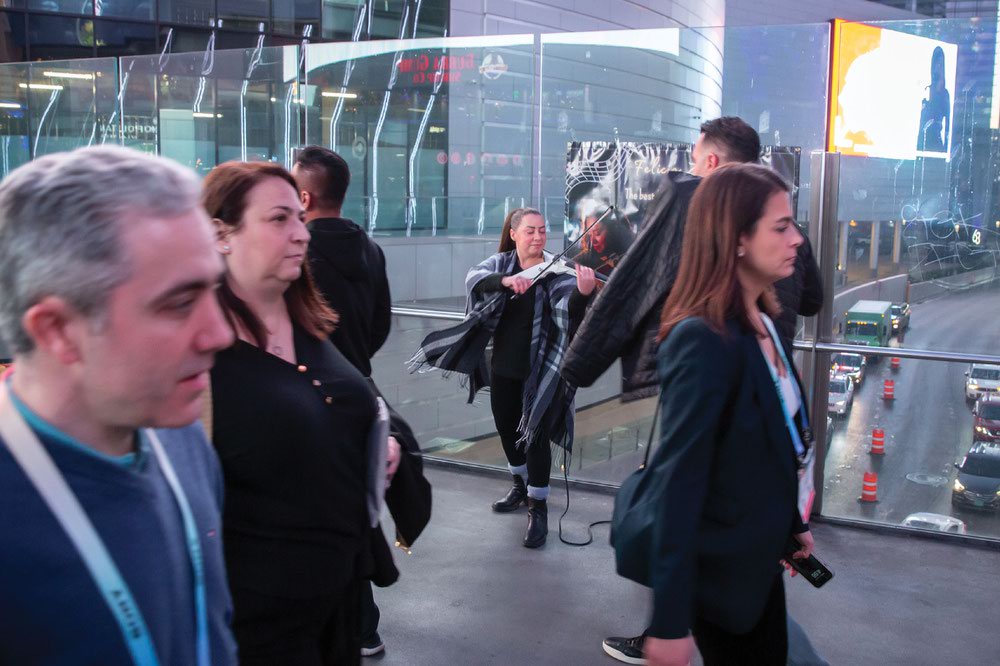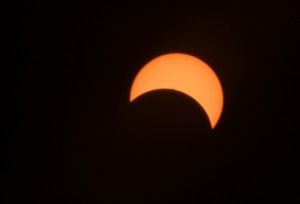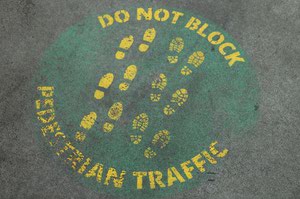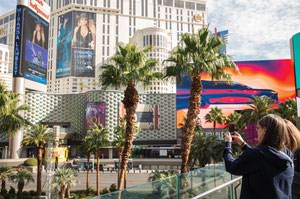Walking out onto the pedestrian bridge that connects the Cosmopolitan with the Shops at Crystals, the sound of Felicia Zaharoff’s violin soars above the crowds of tourists, conventioneers and the din of traffic below.
With accompaniment playing on a speaker, she’s performing a dubstep version of Pachelbel’s Canon, commanding the attention of a few onlookers as she sways her body and flicks her hair with each musical phrase.
“I come up here for the acoustics. And there’s less crime and no other entertainment,” she tells the Weekly. “Down there, there’s a lot of attractions.”
For Zaharoff, performing is about freedom. The Romania-born musician moved to Las Vegas three years ago and has since found a niche in both events and street performing.
“I started studying violin when I was six years old … because, at the time, my country was communist. And being a good violinist was the only way of escaping the borders of my country—by going to international competitions,” Zaharoff says.
“I was searching for freedom. … And that’s the reason why I’m here in America.”
After obtaining a green card and moving to Las Vegas, she started street performing in the summer of 2021. She says it supplements her income from playing events, and has helped her connect with other musicians and opportunities for gigs—some even on the Strip.
“Before [moving to America] I didn’t do street performing. … Coming here and not knowing anybody was hard. And I said, I’ll give this a try. … I met a lot of people through it. And this is how I got to have almost all of the events [I’ve played] and got to play in the casinos too.”
But Zaharoff has met a serious obstacle: a new ordinance passed by the Clark County Board of Commissioners that makes it illegal to stop or stand on the pedestrian bridges where she usually plays. At a January 2 meeting, commissioners voted unanimously to pass the law, which is expected to go into effect January 17.
The policy has proven controversial. Many opponents have argued that the pedestrian bridges, which are technically public sidewalks, are areas where First Amendment activity like street performing should be allowed.
“Street performers don’t want to disobey the law. But the law has to respect the Constitution. We just want to do our job. … [And] this is public property,” Zaharoff says.
While county officials and staff have said the purpose of the law is to provide greater public safety, representatives from the ACLU of Nevada and several other organizations submitted a letter calling the ordinance a “dangerous intrusion on civil liberties.”
Executive Director of the ACLU of Nevada Athar Haseebullah told commissioners that a more sensible solution would be to assign police to patrol pedestrian bridges, rather than implement a policy that could result in misdemeanor charges carrying a sentence up to six months in jail and a fine up to $1,000.
“Despite buzzwords about this being narrowly tailored and the least restrictive alternative, it’s not. … It’s another carceral policy that’s put in place,” Haseebullah told commissioners.
Las Vegas Metropolitan Police Undersheriff Andrew Walsh said the law was necessary to promote public safety and prevent crime and potential “crowd crush” on the bridges during large events. A presentation from William Sousa, director of UNLV’s Center for Crime and Justice Policy, said that calls to Metro for disorderly offenses on the Strip increased 23% between 2018 and 2022. And while the pedestrian bridges make up only 6% of the sidewalk on the Strip, they accounted for 11% of calls for disorderly offenses.
“The ordinance is content-neutral as it applies equally to everyone and is narrowly tailored to address the public safety issues to the pedestrians in the resort corridor, and leaves ample alternative channels of communication, as the pedestrian bridges are only a small part of the entire sidewalk system in the resort corridor,” said Lisa Logsdon, county counsel.
Logsdon also said, per county conversations with the Culinary Union, that the ordinance would allow picketing on the street level.
A representative from the Nevada Resort Association praised the law for its ability to prevent “significant injury” from occurring on the pedestrian bridges should there be a need for rapid evacuation or access for first responders.
ENFORCEMENT
The ordinance calls for the establishment of “Pedestrian Flow Zones” on the pedestrian bridges and up to 20 feet surrounding an elevator, escalator or stairway leading to the bridges. “To maintain safe and continuous movement of pedestrian traffic, it is unlawful for any person to stop, stand, or engage in an activity that causes another person to stop or stand within any Pedestrian Flow Zone,” it reads.
County staff said signage will be put up in Pedestrian Flow Zones to notify the public of the law.
“For those that disobey the signage, officers will first be instructed to inform them, educate them on the law and generate voluntary compliance with the law and keep pedestrians moving,” Walsh told commissioners. “Then, officers will issue a warning and ask folks to move along. And if they refuse, officers will have the ability based on this law to issue a citation or make an arrest.”
In response to concerns about tourists not being allowed to stop on the bridges to take photos, Clark County issued the following statement.
“This is not interpreted to mean that tourists and locals cannot take photos along the Boulevard while on a pedestrian bridge, but rather is intended to maintain the safe and continuous movement of pedestrians on the bridges to ensure pedestrian safety on the bridges,”the statement reads in part.
Opponents of the ordinance raised additional concerns about “selective” enforcement and potential violation of due process. Eve Hanan, director of UNLV law school’s Misdemeanor Clinic, told commissioners that many of the incidents that the clinic deals with arise from arrests and citations that occur in the Strip corridor.
“Our clients are working-class people. They are sometimes working-class people who have fallen through the cracks. They are people maybe trying to make money doing something without the proper license—perhaps vending or something like that. Those are existing crimes,” Hanan told commissioners.
“To add more crimes, to put more fines on them, to put them in positions where they have open cases for months and years, which inhibits them from getting jobs, it’s simply not good policy for this commission.”
Although county lawyers said the law applies equally to everyone, Hanan argued that police discretion in enforcing the policy makes it inherently selective. She cited the Supreme Court case City of Chicago v. Morales, in which the plaintiff successfully sued the city over a law that, according to the high court, violated due process. She also cited the case Desertrain v. City of Los Angeles in which the Ninth Circuit Appeals Court ruled similarly.
“Stopping, standing, the intent to cause someone to stop or stand is simply too vague. … It makes it impossible for an ordinary person to know when they’re in compliance with the law,” Hanan said. “Metro has told us they will use discretion to not arrest those folks, but to let those folks know what the law is and to only arrest others. But that is exactly what Desertrain and Morales and the Supreme Court teaches us—that it’s selective prosecution.”
SUPPOSED IMPACT ON FREE SPEECH
County lawyers have argued that the new ordinance is constitutionally sound because it applies only to 6% of the total sidewalks on the Las Vegas Strip. “All of the speech-related issues that you’ve heard about can occur; if not otherwise prevented in the other 94% of the sidewalk system,” attorney Mitchell Langberg told commissioners.
But policy counsel for the ACLU of Nevada Tia Smith says the fact that pedestrian bridges are technically public sidewalks means that First Amendment activity should be protected there.
“Street performers, political protests or just taking a picture—these all regularly take place on these bridges. And this proposal is so overbroad where it just sweeps up so much First Amendment constitutional activity,” Smith tells the Weekly.
Street performers who spoke with the Weekly say it doesn’t matter that the restrictions apply to only pedestrian bridges. They believe they should be able to perform on 100% of public sidewalks. And they have their reasons for wanting to.
“It gave me an experience as a musician that I didn’t have on stages, no matter how big the stage was,” Zaharoff says. “On the street, if people like you, they will stop and look at you and tip you. But if they don’t like it, they just pass you. This type of experience is really facing the reality that you can’t get at an event or at a concert that is organized.”
Bucket drummer Mike Esquilin, who started performing on the streets in 2022, uses the bridges as a way to get away from crowded areas. “The bridge was a way to escape all the traffic. … I’m not trying to go on Fremont [Street]. There’s so much crowd and competition,” he says.
Outside of the Strip, the Fremont Street Experience Downtown offers regulated street performing where buskers must enter a lottery to perform in assigned spaces in the quasi-public thoroughfare. Both Esquilin and Zaharoff said they don’t like to perform there, mostly because of poor acoustics.
Professional bassist Tony Smith prefers performing on the pedestrian bridges for safety reasons.
“It’s not how much space it is. All the areas are the same—they’re public walkways,” he tells the Weekly.
“I feel safer on the bridges than I do anywhere else; because I’ve witnessed crimes committed down on the ground where guys can get away very easily. But on the bridge, there’s so many people watching, and it creates helpers, too,” Smith says.
THE UNDERLYING REASON
Smith says he has been street performing on the Strip four to six times a week for 13 years, and in that time he has never seen an issue with crowding on the pedestrian bridges ... until the Formula 1 event last November.
During F1, several local reports surfaced of people gathering on bridges and ripping the privacy screens from the glass barriers in order to watch the practices and race.
“The only time … is when the races came. That’s the only time traffic actually stopped on the bridges,” Smith says. “What they’re trying to do is find a loophole to accommodate those races. … It’s all about money.”
Conversely, police say the Pedestrian Flow Zones ordinance is necessary for public safety.
“We’ve seen large crowds on bridges during major events. And [when] the pedestrian bridges get packed, it’s very difficult for officers to get onto those bridges and to maintain order,” Walsh told commissioners at the January 2 meeting.
“We’ve been very lucky so far that we have not had a crowd crush type of incident on those bridges where people were injured.”
In a statement issued immediately after commissioners voted to pass the new ordinance, Clark County reiterated the purpose of the new law was “to reduce crime and enhance safety along the Las Vegas Boulevard.”
“The Pedestrian Flow Zone ordinance will help to ensure our world-class tourism destination remains a safe place for people to visit and transverse,” the county’s statement reads in part.
The rationales for the ordinance don’t satisfy Smith, though. He believes commissioners have a “conflict of interest” when it comes to the casinos. And keeping alternative forms of entertainment off the Strip’s public walkways is in casinos’ best interest, he says.
“I’ve been ticketed several times by cops, and some of them are straightforward with me. They say, ‘Look, man, there’s cameras out here and we have to look like we’re doing our job. … The casinos don’t want you out here,’” Smith says.
PART OF THE STRIP EXPERIENCE
As violinist Zaharoff plays on the pedestrian bridge near the Cosmopolitan, several people stop to clap along to the music, take videos or just smile as they watch her.
“She brings levity to the scene,” says Nicole Sangari, visiting Vegas on business. “Where would we be without art like this?”
Bassist Smith says high-level performers like Zaharoff and himself—people who have spent their lives mastering their craft and playing professionally—have the potential to represent the city and leave a lasting impression on tourists.
“It’s supposed to be the Entertainment Capital of the World. I think we represent this city. And there’s other top-tier musicians and entertainers who represent the city very well, so [that] when people come, it’s a part of their experience. They email me, ‘What a great time we had’,” Smith says.
And while street performers still have an opportunity to play on street-level sidewalks, bucket drummer Esquilin expects those sidewalks will start to get crowded. “Once they take [bridges] away, it’s going to cause clutter on the streets, and people are going to start arguing over spots. … There’s going to be so many people on the street that it’s going to become just like Fremont,” he says.
Zaharoff plans to continue performing on Las Vegas Boulevard. But she’s concerned that if a new law could take away her right to play on pedestrian bridges, other laws could be passed that would further restrict her freedom.
“They take the territory little by little,” she says.
Click HERE to subscribe for free to the Weekly Fix, the digital edition of Las Vegas Weekly! Stay up to date with the latest on Las Vegas concerts, shows, restaurants, bars and more, sent directly to your inbox!








